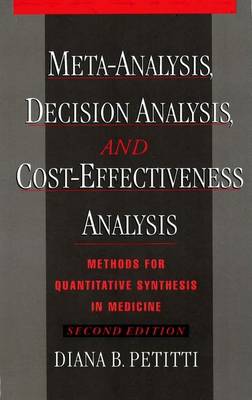
- Afhalen na 1 uur in een winkel met voorraad
- Gratis thuislevering in België vanaf € 30
- Ruim aanbod met 7 miljoen producten
- Afhalen na 1 uur in een winkel met voorraad
- Gratis thuislevering in België vanaf € 30
- Ruim aanbod met 7 miljoen producten
Zoeken
Meta-Analysis, Decision Analysis, and Cost-Effectiveness Analysis
Methods for Quantitative Synthesis in Medicine
Diana B Petitti
€ 159,95
+ 319 punten
Omschrijving
Meta-analysis, decision analysis, and cost-effectiveness analysis are the cornerstones of evidence-based medicine. These related quantitative methods have become essential tools in the formulation of clinical and public policy based on the synthesis of evidence. All three methods are taught with increasing frequency in medical schools and schools of public health and in health policy courses at the undergraduate and graduate level. This book is a lucid introduction, and will serve the needs of students taking introductory courses that cover these topics. It will also be useful to clinicians and policymakers who need to understand the quantitative underpinnings of the methods in order to best apply the information that derives from them. The second edition of this popular book adds new material on cumulative meta-analysis as a method to explore heterogeneity. The coverage of cost-effectiveness analysis has been brought into close alignment with recommendations of the U.S. Public Health Panel on Cost-Effectiveness Analysis in Health and Medicine. Many of the examples have been replaced with more current examples, and all of the material has been updated to reflect recent advances in the methods and the emergence of consensus about some previously controversial issues. analysis. These three closely related methods have become even more important for synthesizing research since the first edition was published in 1994. And they have gained legitimacy as tools for guiding health policy.
Specificaties
Betrokkenen
- Auteur(s):
- Uitgeverij:
Inhoud
- Aantal bladzijden:
- 320
- Taal:
- Engels
- Reeks:
- Reeksnummer:
- nr. 31
Eigenschappen
- Productcode (EAN):
- 9780195133646
- Verschijningsdatum:
- 14/10/1999
- Uitvoering:
- Hardcover
- Formaat:
- Genaaid
- Afmetingen:
- 165 mm x 240 mm
- Gewicht:
- 594 g

Alleen bij Standaard Boekhandel
+ 319 punten op je klantenkaart van Standaard Boekhandel
Beoordelingen
We publiceren alleen reviews die voldoen aan de voorwaarden voor reviews. Bekijk onze voorwaarden voor reviews.











